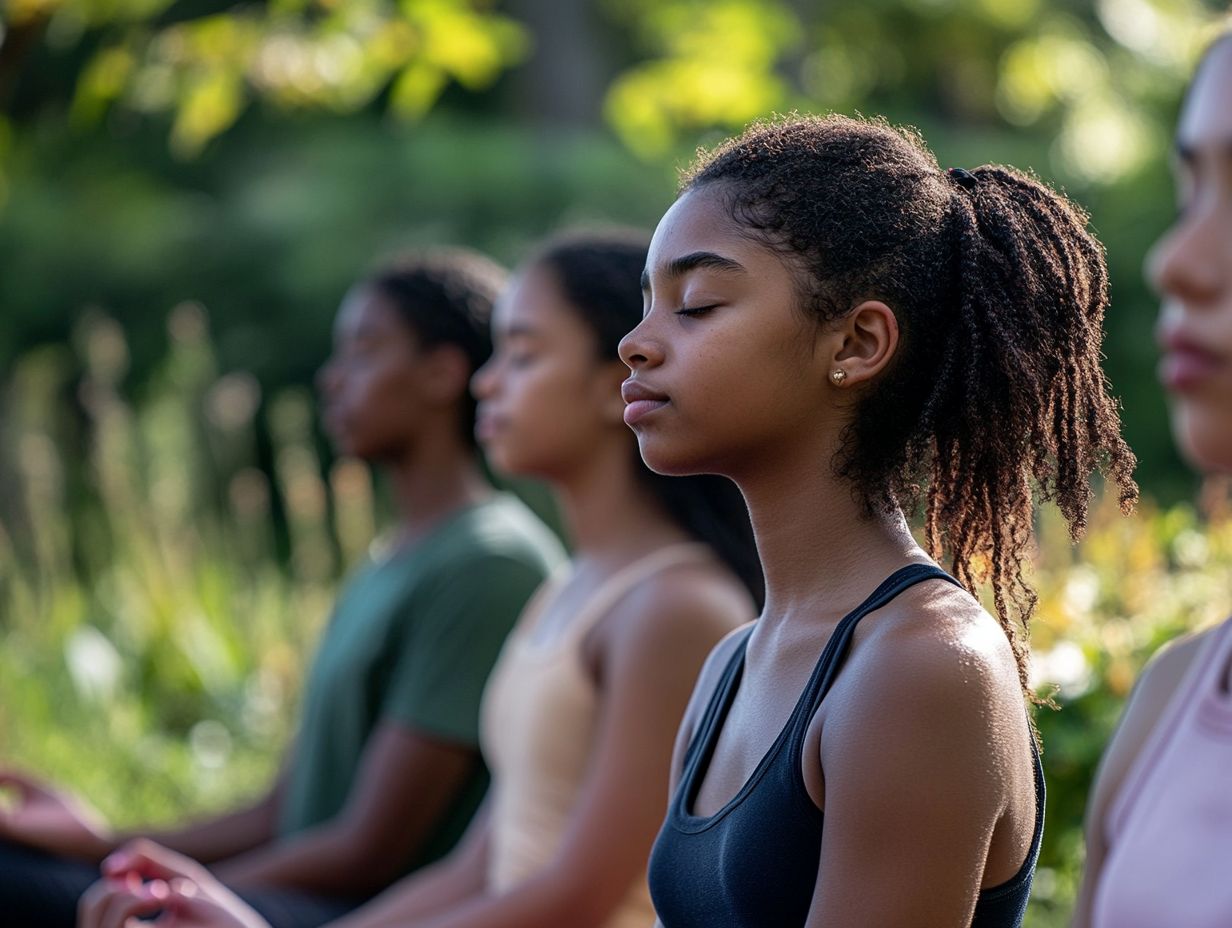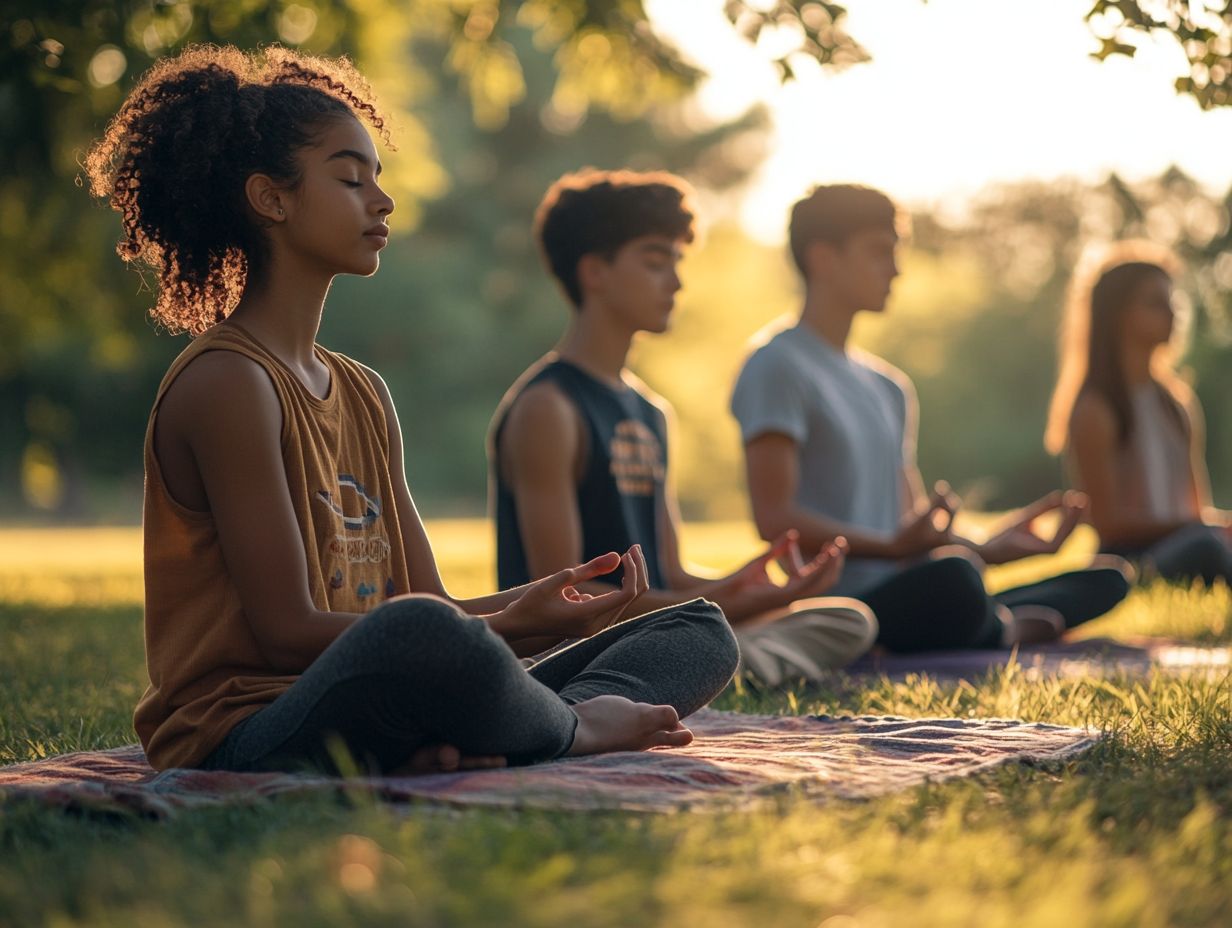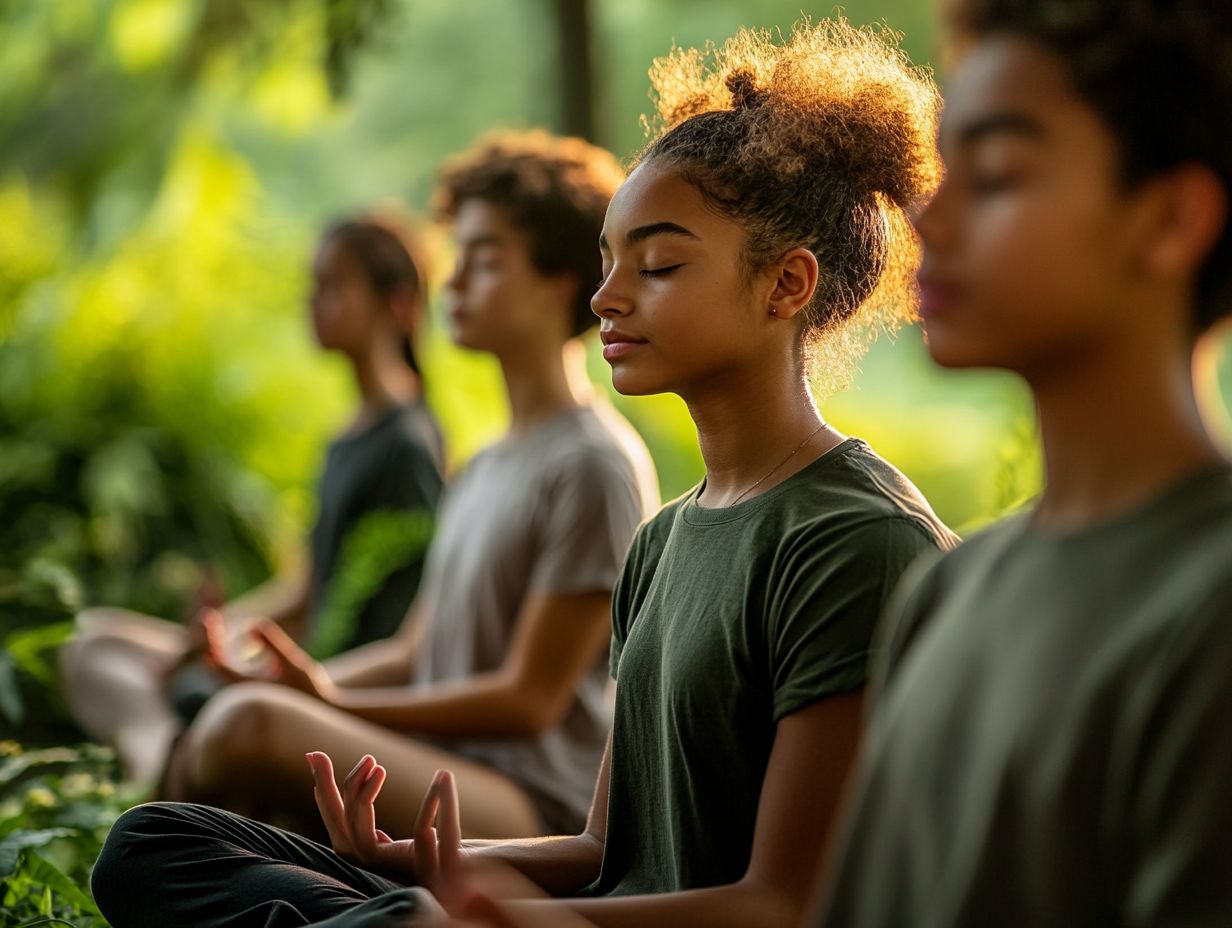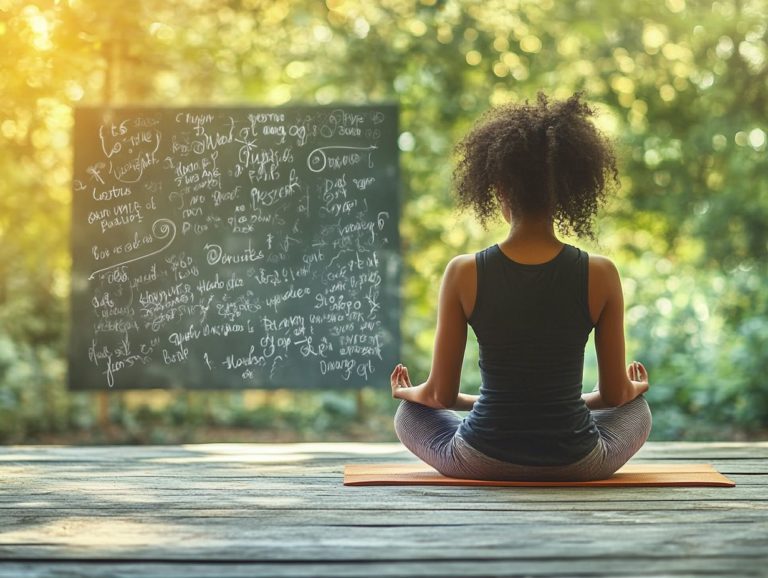5 Essential Mindfulness Techniques for Teens
In today s fast-paced world, you may find that teenagers face unique challenges that can lead to stress, anxiety, and overwhelming emotions. Practicing mindfulness serves as a powerful antidote, enabling them to build awareness and resilience in the face of these pressures.
This article delves into five essential mindfulness techniques like deep breathing exercises and gratitude journaling that can empower teens to navigate their daily lives with greater ease. It also highlights the benefits of mindfulness, addresses common challenges, and provides insights on how parents can support their teens on this transformative journey.
Continue reading to discover how mindfulness can truly transform the teenage experience.
Contents
- Key Takeaways:
- 1. Deep Breathing Exercises
- 2. Body Scan Meditation
- 3. Mindful Eating
- 4. Gratitude Journaling
- 5. Visualization Techniques
- How Can Mindfulness Benefit Teenagers?
- What Are the Challenges of Practicing Mindfulness as a Teen?
- How Can Parents Encourage Mindfulness in Their Teenagers?
- What Are the Potential Risks of Not Practicing Mindfulness as a Teen?
- What Are the Different Ways to Incorporate Mindfulness into Daily Life?
- How Can Mindfulness Help with Common Teenage Issues?
- Frequently Asked Questions
- Why are these techniques important for teens?
- How can teens incorporate these techniques into their daily routine?
- Can these techniques be helpful for teens with mental health issues?
- Are there any resources available for teens to learn more about these techniques?
- Are there any tips for implementing these techniques in a group setting?
Key Takeaways:

Practice deep breathing to calm your mind and boost focus!
Try body scan meditation to increase awareness of your body and release tension.
Mindful eating means paying close attention to what you eat and helps build a healthy relationship with food.
1. Deep Breathing Exercises
Deep breathing exercises serve as a cornerstone of mindfulness techniques. They offer effective tools to help children manage their emotions, reduce anxiety, and enhance their overall well-being.
Through simple yet powerful breathing techniques, these practices promote self-regulation and focus. One particularly valuable method is the 4-7-8 technique. In this approach, children inhale for four seconds, hold their breath for seven seconds, and then exhale slowly for eight seconds.
By breaking it down in this way, kids can easily follow along and incorporate it into their daily routines. They can use this technique before tackling homework or winding down for bedtime. This practice not only soothes the nervous system but also sharpens concentration, making it essential in our fast-paced world.
Encourage this habit with mindfulness apps or guided videos tailored specifically for children, keeping them engaged and motivated to fully explore the benefits of mindful breathing.
2. Body Scan Meditation
Body scan meditation is a powerful mindfulness practice that enables you to help children develop a heightened sense of body awareness. This can lead to improved emotional regulation and a deeper connection to their physical sensations.
This practice encourages kids to focus on each part of their body one at a time, starting from their toes and moving up to the crown of their head. As they do this, they learn to pinpoint areas where they hold tension or discomfort, providing valuable insight into their emotional states.
For example, a child may notice tightness in their shoulders when they’re feeling anxious, giving them the power to recognize and address these feelings more effectively.
By incorporating simple techniques such as lying down comfortably and taking deep breaths young practitioners can cultivate a sense of calm. This not only helps them manage stress but also fosters self-awareness, ultimately enhancing their overall well-being.
3. Mindful Eating
Mindful eating means paying close attention to what you eat. It encourages children to engage with their food thoughtfully and intentionally, fostering a deeper appreciation for flavors, textures, and the present moment. This practice can make a real difference in their happiness and health!
By incorporating simple activities like food journaling or sensory exploration, you can help children cultivate a heightened awareness of their eating habits. For example, asking them to describe the colors and shapes of their meals can sharpen their observational skills and connect them to the origins of their food.
Emphasizing slow eating practices, where they take smaller bites and savor each mouthful, can promote feelings of satisfaction and fullness, effectively reducing the chances of overeating.
These methods not only instill a sense of gratitude for nourishment but also equip young minds with the tools to make healthier choices in the long run, nurturing a lifelong appreciation for balanced diets and mindful living.
Encourage parents to try these techniques with their teens for a truly transformative experience!
4. Gratitude Journaling

Gratitude journaling is a powerful mindfulness exercise for children. It enables them to share their thoughts and feelings, which fosters emotional regulation and supports mental health.
This practice encourages young minds to reflect on their daily experiences, making it easier to appreciate the small joys life offers. By consistently jotting down their thoughts, they cultivate a habit of positive thinking that enhances their mental resilience.
To embark on this rewarding journey, guided prompts can be invaluable. For example, you might ask them:
- “What made you smile today?”
- “Who is someone you are thankful for and why?”
These questions ignite creativity and deepen emotional awareness, allowing gratitude to seamlessly integrate into their daily routine ultimately enriching their well-being.
5. Visualization Techniques
Visualization techniques are mindfulness practices that empower children to reduce anxiety and cultivate a positive mental state. They encourage kids to imagine serene and calming scenarios, enhancing their overall mental health.
These exercises help children alleviate stress and develop a stronger sense of focus and resilience. For example, guiding them through an exercise where they envision a safe place like a tranquil beach or a cozy treehouse offers a temporary escape from worries.
To get started, invite children to close their eyes and take deep breaths. Encourage them to visualize the details of their safe space, including the colors, sounds, and emotions associated with it. It’s also beneficial to introduce them to visualizing desired outcomes, such as completing a school project or scoring a goal in sports.
By practicing these visualization techniques regularly, you ll find that mindfulness significantly enhances their well-being, leading to deeper benefits over time.
How Can Mindfulness Benefit Teenagers?
Mindfulness can change your life as a teenager! It offers significant benefits during these years, including improved mental health, reduced anxiety levels, and enhanced social skills.
These strategies help you navigate the complexities of adolescence while promoting emotional resilience. By incorporating techniques such as mindfulness meditation, you learn to focus on your breath and thoughts, developing a deeper awareness of your feelings.
Mindfulness apps designed for your age group provide engaging ways to practice daily. These tools teach essential coping mechanisms and emphasize self-compassion and being present in the moment.
As you face challenges like academic pressure and social anxiety, these mindfulness principles empower you to manage emotions effectively, fostering healthier relationships and a more positive outlook on life.
What Are the Challenges of Practicing Mindfulness as a Teen?
Practicing mindfulness as a teenager presents unique challenges. You might struggle with maintaining focus, managing anxiety, or feeling skeptical about mindfulness techniques.
With a world overflowing with distractions like social media temptations and peer pressure committing to mindfulness can feel like an uphill battle. You often feel pulled away from your inner thoughts by constant notifications and the urge to fit in, making authentic engagement with mindfulness tough.
To navigate these hurdles, personalized mindfulness exercises tailored to your interests can be transformative. Group activities that promote collective reflection, such as guided meditation sessions or nature walks, create a supportive atmosphere.
This encourages you and your peers to explore mindfulness together, sharing experiences in a judgment-free space where everyone feels at ease.
Start exploring mindfulness today and unlock its benefits!
How Can Parents Encourage Mindfulness in Their Teenagers?

Parents play a crucial role in fostering mindfulness in their teenagers by practicing mindfulness and creating supportive environments. Additionally, they can encourage open discussions about mental health and emotional well-being.
To deepen this connection, engage in mindfulness games together. This transforms the experience into a delightful yet meaningful bonding opportunity that helps your teen learn to focus their thoughts and feelings.
Simple activities like deep breathing exercises or guided meditations recordings that help you relax and focus can seamlessly fit into your daily routine. Sharing resources such as books, podcasts, or apps centered around mindfulness empowers your adolescent to explore their emotions independently.
It’s essential to keep communication open about feelings. This allows your teenager to express struggles and fears without the worry of judgment. This supportive environment helps them understand their feelings better and cultivates emotional intelligence while underscoring the vital role mental health plays in their lives.
What Are the Potential Risks of Not Practicing Mindfulness as a Teen?
Neglecting mindfulness during your teenage years can introduce significant risks, including heightened anxiety, poor emotional regulation, and challenges in managing stress. All of these can adversely impact your overall mental health.
Without the ability to cultivate present-moment awareness, you may find yourself more vulnerable to attention issues. This can hinder your academic performance and social interactions, possibly isolating you from supportive networks.
Overlooking mindfulness may worsen existing anxiety, creating a troubling cycle of worry and avoidance.
Conversely, integrating mindfulness practices into your daily routine can act as a protective factor, enhancing your resilience and fostering a greater sense of control over your emotions. By embracing mindfulness, you equip yourself with essential coping skills, paving the way for improved mental well-being and a more balanced life.
What Are the Different Ways to Incorporate Mindfulness into Daily Life?
You can easily make mindfulness a part of your life today! Incorporating mindfulness can take many forms, ranging from simple activities and exercises to more structured training, making it easy for you to practice regularly.
Explore a variety of practical mindfulness strategies that fit seamlessly into your busy schedule:
- Go on mindfulness walks, focusing on your surroundings and your breathing.
- Practice body scans to boost your body awareness.
- Use mindfulness apps that offer guided meditations, which can easily slot into your school routine or help you unwind before bed.
The key to truly reaping the benefits of these practices is consistency. Feel free to experiment with different techniques until you find what resonates best with your lifestyle and preferences. This journey will ultimately enhance your emotional well-being.
How Can Mindfulness Help with Common Teenage Issues?
Mindfulness holds immense potential to tackle common issues faced by teenagers, such as anxiety, social skills, and emotional regulation. It equips you with the necessary tools to effectively navigate these challenges.
For example, many teens feel a surge of anxiety during exams, which can impede performance. By practicing breathing exercises, you can calm racing thoughts and regain focus, enabling you to approach tests with a clearer mind.
Social interactions might seem intimidating at times. However, incorporating gratitude journaling into your routine can dramatically shift your perspective and nurture a more positive outlook on friendships, enhancing social confidence.
By integrating these mindfulness practices into your life, you can build resilience and foster deeper connections with those around you.
Frequently Asked Questions

What are the 5 essential mindfulness techniques for teens?
Here are five essential mindfulness techniques that can help teens: deep breathing, mindful observation, body scan, gratitude practice, and mindful walking.
Start practicing mindfulness today and unlock its transformative power!
Why are these techniques important for teens?
These techniques help teens manage stress and anxiety. They improve focus, concentration, and promote a sense of calm.
How can teens incorporate these techniques into their daily routine?
Teens can practice these techniques for a few minutes each day. Doing this before bed or in the morning is a great start.
They can also include them in daily activities, like taking mindful walks during breaks or practicing deep breathing before a test.
Can these techniques be helpful for teens with mental health issues?
Yes! These techniques can be beneficial for teens facing mental health challenges. Mindfulness, which means being aware of the present moment, can help reduce anxiety and depression.
Are there any resources available for teens to learn more about these techniques?
Many resources exist for teens to learn about mindfulness. Books, apps, and online courses are all excellent options!
Some schools may even offer mindfulness classes or programs. It’s vital for teens to find resources that suit their needs.
Are there any tips for implementing these techniques in a group setting?
To effectively implement these techniques in groups, start with a short guided practice. Afterward, create space for discussion in a supportive environment.
Encourage open and non-judgmental conversations to make participants feel comfortable.






